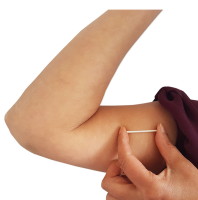
The implant is a soft piece of plastic that's put in under the skin of the arm.
It contains one hormone (a progestogen), which is very similar to one of the body's own hormones.
It lasts for 3 years, but can be taken out at any time.
Positives
- It's extremely good at preventing pregnancy
- Very convenient, and doesn’t interrupt sex
- Periods can be lighter and less frequent
- It helps to make periods less painful
- Often suitable for people who can't take oestrogen
- It can be used at any age
Negatives
- A small injection of local anaesthetic is needed to put it in
- Irregular bleeding can be a nuisance (for 1 in 5 users)
- Some people get side effects like mood changes and changes in sex drive
- No protection against STIs
You don’t need a break from the implant
It’s perfectly safe to use the implant for as long as it’s needed
The body doesn’t need a period once a month
The implant stops the lining of the womb from building up – blood doesn’t build up inside, and it can help people feel more energetic if they are not losing iron each month in a period. Find out more about periods here
The implant does not cause infertility
When you come off the implant, fertility returns to normal very quickly. It’s important to know that it’s less easy to get pregnant as you get older – it’s naturally harder to get pregnant over the age of 35 (although this can definitely still happen). Find out more about infertility here
Many are on the implant for its benefits, even if they don't need it for contraception
Many find the implant good at controlling period pain and stopping periods.
The implant is a great choice for women who find the pill difficult to remember
The implant lasts for 3 years, so there’s no need to remember to take a pill every day. Apps and text reminder services are available to help women remember when to change their implant
A clinic visit is needed to ask about any problems with your health and family history
Some health problems mean that the implant won’t be suitable, but most people can have it.
Good to know
Some people love the implant, and others don't get on with it at all.
The implant is incredibly convenient and can help period pain and heavy bleeding.
Periods can change a lot. Many find their periods become less frequent or lighter. One in four people won’t have any periods at all, and about 1 in 5 will have periods or light bleeding (spotting) that's irregular, or have heavier bleeding that becomes a nuisance. Changes in periods won't cause any harm and won't stop you getting pregnant in future.
Seek advice if irregular periods or bleeding are a problem, because there are ways of settling it down. The implant is easy to take out if it's not the right choice.
How much effort is the implant?
It’s put in under the skin of the upper arm by a trained doctor or nurse and lasts for 3 years. There's a sharp jab from a small injection of local anaesthetic, and then it's not painful when it's put in.
The implant is free from GPs, family planning/contraception clinics and sexual health clinics. Find out more about where to get the implant here
How effective is the implant?
The implant is the most effective method available – over 99%. This means that if 100 people used the implant for a year, less than 1 of them would become pregnant.
How does it work?
The implant temporarily stops your ovaries from releasing an egg each month. It also thickens the fluid around the neck of the womb (which stops sperm getting to an egg), and makes the lining of the womb thinner so that a fertilised egg won't settle and grow.
Once it’s taken out, fertility returns to normal very quickly – usually within a week.
Does the implant affect my risk of getting cancer?
Studies have shown a small increased risk of breast cancer in people who use hormonal contraception compared to people that don't. This increased risk disappears 10 years after you stop using the implant.
